#Jwaneng Mine
Text
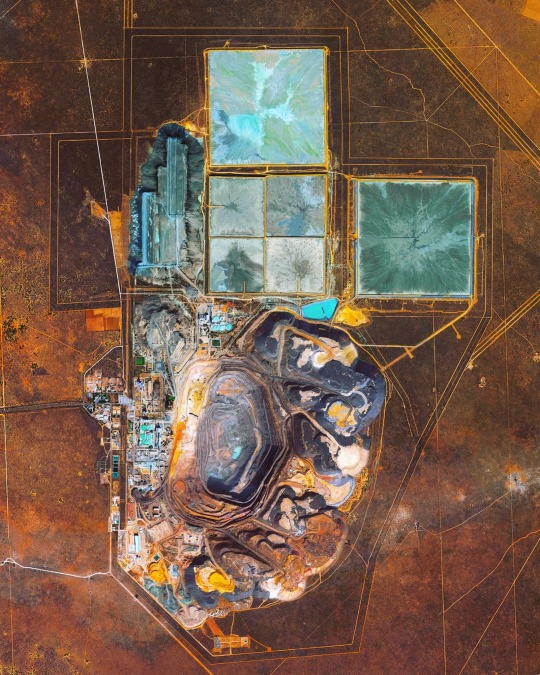
The Jwaneng Diamond Mine in Botswana is the richest diamond mine in the world, with an annual output of as much as 15.6 million carats. Mine richness takes into account the rate of diamond extraction combined with quality of the diamonds that are mined, by sale price per weight. To extract the diamonds, the facility produces 9.3 million tons of ore and an additional 37 million tons of waste rock per year.
See more here: https://bit.ly/3sndIkK
-24.523050°, 24.699750°
Source imagery: Maxar
292 notes
·
View notes
Text
World’s 10 Largest Diamond Mines
Listed below are the ten largest diamond mines by manufacturing the world over in 2022, in response to GlobalData’s mining database.

1. Jwaneng Mine
The Jwaneng Mine is a floor mine located in Kgalagadi District, Botswana. Owned by Authorities of Botswana, the greenfield mine produced an estimated 18,725 thousand carats of diamond in 2020. The mine will function till 2036.
2. Kao Mine
Situated in Butha-Buthe, Lesotho, the Kao Mine is owned by Namakwa Diamonds. The floor mine produced an estimated 12,384 thousand carats of diamond in 2020. The mine will function till 2034.
3. Orapa Mine
The Orapa Mine is a floor mine positioned in Central District, Botswana. Owned by Authorities of Botswana, the greenfield mine produced an estimated 9,021 thousand carats of diamond in 2020. The mine will function till 2036.
4. Catoca Mine
Owned by ALROSA, the Catoca Mine is a floor mine located in Lunda Sul, Angola. The greenfield mine produced an estimated 7,372 thousand carats of diamond in 2020. The anticipated mine closure date is 2037.
5. Gahcho Kue Mission
The Gahcho Kue Mission is a floor mine located in Northwest Territories, Canada. Owned by Mountain Province Diamonds, the greenfield mine produced an estimated 6,518 thousand carats of diamond in 2020. The mine is anticipated to function till 2030.
6. Diavik Mine
The Diavik Mine is an underground mine located in Northwest Territories, Canada. Owned by Rio Tinto, the brownfield mine produced an estimated 6,218 thousand carats of diamond in 2020. The mine will function till 2025.
7. Jubilee Mine
Situated in Sakha (Yakutia) Republic, Russia, the Jubilee Mine is owned by ALROSA. The floor mine produced an estimated 6,209 thousand carats of diamond in 2020. The mine will function till 2030.
8. Superkolong Mission
The Superkolong Mission is a floor mine positioned in Northern Cape, South Africa. Owned by Batla Minerals, the brownfield mine produced an estimated 4,412 thousand carats of diamond in 2020.
9. Udachny Mine
Owned by ALROSA, the Udachny Mine is an underground mine located in Sakha (Yakutia) Republic, Russia. The greenfield mine produced an estimated 4,143 thousand carats of diamond in 2020. The anticipated mine closure date is 2037.
10. Vladimir Grib Mission
The Vladimir Grib Mission is a floor mine located in Arkhangelsk Oblast, Russia. Owned by Otkritie Holding, the greenfield mine produced an estimated 3,931 thousand carats of diamond in 2020. The mine is anticipated to function till 2033.
Methodology: This data is drawn from GlobalData’s mines and initiatives database, which tracks all working and growing mines and initiatives globally. Verdict’s father or mother firm GlobalData supplies enterprise data to 4,000 of the world’s largest corporations.
3 notes
·
View notes
Text

The Jwaneng Diamond Mine in Botswana is the richest diamond mine in the world, with an annual output of as much as 15.6 million carats.
Mine richness takes into account the rate of diamond extraction combined with quality of the diamonds that are mined, by sale price per weight. To extract the diamonds, the facility produces 9.3 million tons of ore and an additional 37 million tons of waste rock per year.
1 note
·
View note
Text

Exporter of Sink Floating Machine in Botswana R Mech Machines LLP is a global leader in exporting, supplying, and manufacturing Pet Bottle Label Removing Machines, among various other products.
Sink floating machines play a crucial role in efficiently separating and recovering valuable materials from mixed waste streams in recycling facilities, waste management centers, and mining operations.
In recycling, mining, waste management, and other industries, these machines separate heavier materials from lighter materials based on density differences.
This process enables efficient recovery of valuable materials and enhances waste management practices.
Features: Sink floating machines offer a cost-effective solution for material separation tasks, improving overall efficiency and resource utilization.
They effectively separate materials based on density differences, allowing efficient separation of heavier and lighter materials.
Designed for high throughput, sink-floating machines can process large quantities of material efficiently.
Engineered for reliability and low maintenance, ensuring smooth operation and reduced downtime.
The design of sink-floating machines ensures precise separation, enabling the recovery of valuable materials from mixed waste streams.
R Mech Machines takes pride in being an Exporter of Sink floating Machine in Botswana and various locations, including Gaborone, Francistown, Molepolole, Maun, Serowe, Kanye, Mahalapye, Mogoditshane, Lobatse, Selebi-Phikwe, Palapye, Ramotswa, Mochudi, Tonota, Letlhakane, Thamaga, Orapa, Shakawe, Jwaneng, Kasane, etc.
If you are interested in our high-quality products, kindly contact us for further information.
0 notes
Text
Is Botswana Getting a Raw Deal From De Beers Diamonds?
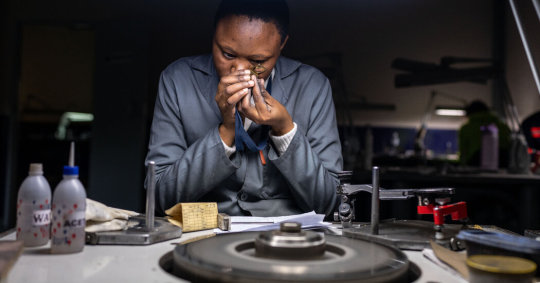
Botswana produces more of the world’s diamonds than any country but Russia. But Botswana, a small landlocked nation in southern Africa, keeps only 25 percent of the rough stones extracted in its agreement with De Beers, an international diamond conglomerate. De Beers takes 75 percent.That disparity has been at the heart of an argument by the president, Mokgweetsi Masisi, that his country is getting a raw deal from De Beers, a London-based company. Mr. Masisi has said that if Botswana does not get more, it might walk away from the half-century-old partnership when the current agreement expires on Friday.“We must refuse to be enslaved,” he proclaimed last month during a community meeting at a village 250 miles north of the capital, Gaborone.In publicly ratcheting up the pressure against De Beers, Mr. Masisi is raising a question now echoing across the continent: Can African countries keep a greater share of their wealth?Sierra Leone, Tanzania and Uganda, with vast mineral wealth and rich oil and gas reserves, are among many countries pressing to hold onto more of the profits from their lucrative resources, arguing that it’s necessary to lift people out of poverty. Long histories of colonial theft, as well as government corruption and mismanagement, have prevented many Africans from benefiting from their nations’ natural riches.Botswana has profited far more than many other developing countries from its minerals. Since De Beers found diamonds in 1966 and mining revenues began to flow, life expectancy has climbed from 37 to 61 years.Today, many of Botswana’s 2.4 million people live in sturdy homes with reliable utilities, have access to free health care and a good education. Botswana has the sixth-highest gross domestic product per person in Africa, the World Bank says. In Gaborone, shopping malls are aplenty and the roads are wide and smooth.But even in Botswana, where the benefits of mineral wealth have spread, many argue that their country is being cheated: the diamonds belong to them, they say, and it’s time for De Beers to take a back seat.“Let us do it our way,” said Boingotlo Motingwa, 39, who works for a subcontractor at Jwaneng Mine, the world’s most lucrative diamond mine, about two hours west of Gaborone. “We are learned enough now. Like those diamonds, we are processed now.”Botswana had very little expertise in diamonds, and few resources to mine them, when it first partnered with De Beers. Now, many feel that the country has the experience to wean itself off the corporate giant.Many Batswana, as the country’s citizens are called, are also demanding more from the deal because their country is one of the most unequal in the world, according to the World Bank.Barely a five-minute drive from Jwaneng Mine sits a community of boxy yellow and green homes that have no electricity or indoor plumbing. Each night, seven members of the Tsile family cram into a tiny unit costing $11.50 a month. With few jobs available, this was the best they could afford.“These diamonds are only working for the president, not the ordinary person,” said Kefilwe Tsile, 44 and unemployed.In fact, with elections scheduled for next year, some said they regard the president’s challenge to De Beers as political posturing.De Beers secured prospecting rights in Botswana in 1938, when the country was still under British rule. The company first found diamonds beneath Botswana’s arid plains in 1966, the same year the country gained independence.Over the years, Botswana has eked out a little more each time the deal has been renewed with De Beers, which declined to comment for this article.De Beers originally kept all of the diamonds it mined. Over time, the Botswana government got an allotment and in 2004 it received a 15 percent ownership stake in De Beers.Botswana’s early leaders prudently spent and saved the diamond earnings, and there was little corruption, which helped the country flourish, according to analysts.Since De Beers also pays taxes and royalties on the stones it mines, Botswana’s government makes out better than De Beers in raw financial terms than the 25/75 split would suggest. Botswana earns about 80 cents for every dollar worth of diamonds extracted by De Beers. That amounted to about $2.8 billion for Botswana last year.But that’s no reason to celebrate, said Lefoko Fox Moagi, Botswana’s minister of minerals and energy. For any company, taxes and royalties are part of doing business, he said. He is more worried about the share of diamonds the government receives.“If we are equal partners in this, why am I still sitting at 25 percent?” he asked.Most of the rough diamonds mined in Botswana are shipped to manufacturing hubs like Surat, India, where they are cut and polished into the shiny crystals that greatly increase their value.Botswana is demanding that more cutting and polishing — as well as jewelry-making and retail sales — happen within its borders, Mr. Moagi said. De Beers has been attracting some buyers to manufacture in Botswana, promising a preferential allocation of stones.One of those buyers, Venus Jewel, opened a manufacturing facility in Gaborone last year. About half of the company’s manufacturing work force in Botswana is from India, but the company hopes locals can eventually take on most of the work, said Lesego Matsheka, Venus’s managing director in Botswana.“Most of us grew up with a farm,” she said, referring to her fellow Batswana. “Diamond polishing is something very new.”Any new deal with De Beers, which profits handsomely from cutting, polishing and selling its Botswana-mined diamonds, would have to include provisions for Botswana to maximize its revenue in those areas, Mr. Moagi said.“Nobody’s ever ready for a divorce,” he said. “But if you are told to get out of the house, you get out of the house. De Beers is not the only company in the world.”As if to prove that the Botswana government isn’t afraid to find a new partner, Mr. Masisi has announced that the government would purchase a 24 percent stake in HB Antwerp, a three-year-old Belgian company. It buys rough stones from Lucara Diamond, a company with one Botswana mine. But instead of just paying Lucara the rough stone price, HB pays a percentage of the value of the final polished stone.That model attracted the government, Mr. Moagi said. Still, the partnership, which has yet to be finalized, has raised alarm among industry experts in Botswana. Many question why the government would partner with such a young and small company when other, larger diamond manufacturers have been operating in the country for at least a decade.Sheila Khama, the former chief executive of De Beers in Botswana, used to advise governments on natural resource management. Botswana, she said, should focus on how to make it “worthwhile for De Beers to stay in the business of natural diamonds and in the partnership.”Botswana had the best profit-sharing deal she had ever seen between a country and a mining company, she said. When she was with De Beers, she said, Botswana’s government received about $250 million every six weeks in dividend payments, because of the stake it owns in the company. Now she worries about the effect of the heated rhetoric.“If in the end it plants the thought on De Beers’s mind to find an exit,” she said, “our diamond resources could potentially become sterile.”Yvonne Mooka contributed reporting from Gaborone, Botswana.
Source link
Read the full article
0 notes
Photo

Botswana reports single COVID-19 death, first in four months Botswana reported a single COVID-19 death Monday, the southern African country’s first in four months, Botswana’s health authorities confirmed. The death occurred in Jwaneng, a mining township about 200 km southwest of Gaborone, the capital of Botswana, which has been the hardest hit by the nationwide resurgence of cases, Christopher Nyanga, the spokesperson of Botswana’s Ministry of Health, Read more..... https://africanfutureleadership.com/botswana-reports-single-covid-19-death-first-in-four-months https://www.instagram.com/p/CnRWHkXtIFs/?igshid=NGJjMDIxMWI=
0 notes
Text
The world’s top 10 biggest diamond mines
The ten biggest precious stone mines on the planet by quantifiable stores contain more than one billion carats of recoverable jewels. Russia is home to half of the world's greatest jewel mines while Botswana houses two. Mining-technology.com profiles the main ten greatest mines in view of jewel holds and excluding alluvial precious stone mining projects.
Aikhal
Aikhal situated in Sakha (Yakutia), Republic of Russia, is the world's greatest gold mine market. It involves different stores, including the Celebration Line, Aikhal Line, Komsomolskaya Line, and Zaria Line, which together are assessed to contain 175.56 million carats (Mct) of demonstrated and plausible stores as of July 2018.
The precious stone mine is possessed and worked by the Aikhal mining and processing division of Russian jewel organization Alrosa. The Celebration and Komsomolskaya pipes are mined through open-pit techniques. The Celebration pipe is at present operating at a profundity of 390m and intended to arrive at an extreme profundity of 720m.
The Aikhal pipe was likewise mined through open-pit techniques until 1997 preceding it changed to underground mining using the cut-and-fill mining strategy. The Zaria pipe is right now a work in progress and will be mined through open-pit strategies using particular mining. Business creation from the open-pit is supposed to start in 2021.
For more diamond mining market insights, download the free sample report
Jwaneng
The Jwaneng precious stone mine in Botswana is an open-pit mine found 160 miles south-west of Gaborone. It was assessed to contain demonstrated and likely jewel stores of 166.6Mct as of December 2018.
Possessed by Debswana Jewel Organization, a 50:50 association between De Brews (a piece of Somewhat English American Gathering) and the Public authority of Botswana, Jwaneng is viewed as the world's most extravagant precious stone mine with regards to esteem. The mine has been underway since 1982 and represents up to 70% of Debswana's incomes. The organization works four jewel mines in Botswana.
The ongoing operating profundity of the Jwaneng pit is 400m. A significant expansion project, named Cut-9, is in progress at Jwaneng to stretch out the mine's life to no less than 2034.
Udachny
The Udachny precious stone mine, situated in the Yakutia locale of Russia, positions as the world's third-biggest jewel mine by hold size. The mine is possessed by Alrosa and worked by its Udachny mining and processing division.
The mine involves the Udachnaya Line, Zarnitsa Line and the Verkhne-Munskoe store, which together are assessed to contain 164.46Mct of demonstrated and plausible stores as of July 2018.
The open-pit activities at the Udachnaya pipe were started in 1971 and holds were exhausted by 2016. Longhole retreat stoping is presently being utilized at the mine to get to the underground holds. The Zarnitsa Line is an open-pit mining activity that utilizes ordinary truck and digging tool gear. The mine is at present operating at a profundity of 110m and intended to reach 200m.
The Verkhne-Munskoe store contains five lines including Zapolarnaya, Deimos, Novinka, Komsomolskaya-Magnitnaya, and Poiskovaya. The store was authorized in October 2018 and the main jewel quality precious stone was recuperated from the Zapolarnaya pipe in November 2018.
Nyurba
Nyurba is an open-pit mine found 200km northwest of Nyurba, Russia. It is claimed by Alrosa and worked by the Nyurba mining and processing division.
The mine comprises of three stores, including Nyurbinskaya Line, Botuobinskaya Line and Maiskoye Kimberlite Body. They together contained an expected 132.75Mct of demonstrated and plausible stores as of July 2018.
The Nyurbinskaya pipe is mined through open-pit strategies with its ongoing profundity reaching 345m and planned profundity being 750m. Mining tasks at Nyurbinskaya were started in 2000. The Botuobinskaya pipe lies 3km south of the Nyurbinskaya store. Overburden evacuation at the mine initiated in 2014 and creation began in 2015.
The Maiskoye kimberlite store lies 3km south of the Botuobinskaya pipe. It is wanted to be mined through open-pit techniques with advancement planned for 2022.
Orapa
The Orapa jewel mine is found 240km west of Francistown, focal Botswana. The open-pit mine was assessed to contain 131.2Mct of demonstrated and plausible stores as of December 2018.
Producing since 1971, Orapa is the most seasoned of the four jewel mines worked by Debswana. Mining is at present being embraced at a profundity of 250m and is supposed to reach 450m by 2026.
Debswana is at present conducting a definite report to broaden the mine life through another open-pit named Cut 3. Mining exercises under the venture are supposed to start in January 2021 and will initially run for quite some time with a likelihood to broaden it until 2030.
0 notes
Photo

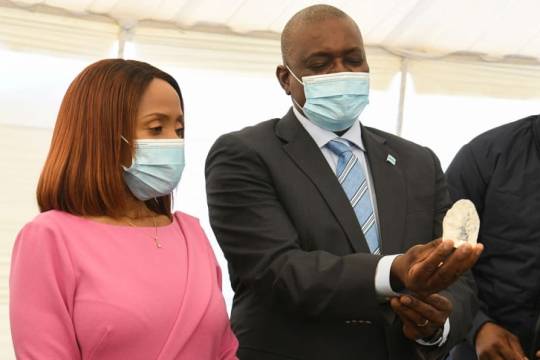

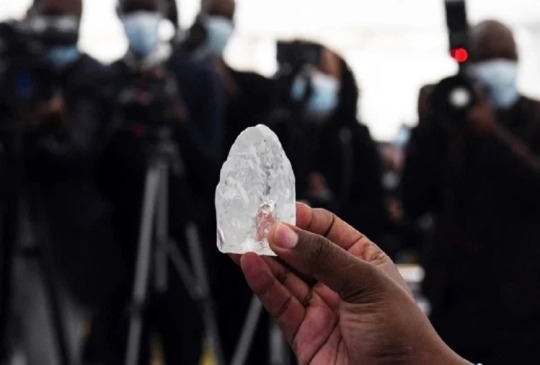

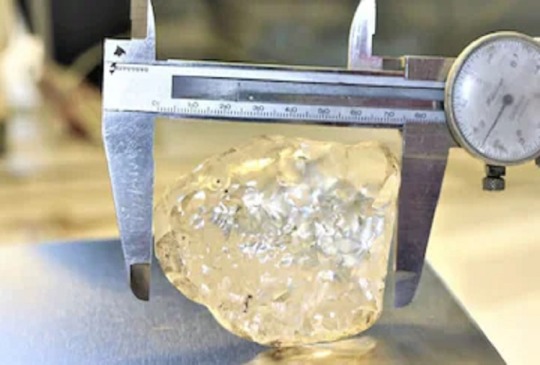

The World's Third Largest Largest Diamond has been Found in Botswana
One of the world's largest diamonds has been unearthed in Botswana, the country's government has announced.
The 1,098-carat stone, believed to be the third largest "gem-quality" diamond ever found, was presented to President Mokgweetsi Masisi on Wednesday.
The discovery was made earlier this month at the Jwaneng mine, around 75 miles from the country's capital, Gaborone. The mine is operated by Debswana, a diamond company jointly owned by Botswana's government and the De Beers Group, according to its official website.
An official government Twitter account wrote that "proceeds from the diamond will be used to advance national development in the country."
"Debswana should use this latest discovery as an inflection point, for the mine to use its technology to realize more of these large discoveries," it added.
Masisi's office also posted a series of pictures showing the diamond being presenting to the president and his cabinet.
Officially opened in 1982, the Jwaneng mine usually yields between 12.5 million and 15 million carats of diamonds a year, according to Debswana. This month's find is the largest gem unearthed by the company since diamonds were first discovered in Botswana in 1967, the government said.
At present, the largest diamond ever recorded is the 3,106-carat Cullinan Diamond, found in South Africa in 1905. The Cullinan was subsequently cut into smaller stones, some of which form part of British royal family's crown jewels.
The second largest discovery is believed to be the Lesedi La Rona, a 1,109-carat stone found by Canadian firm Lucara Diamond at the Karowe mine, also in Botswana, in 2015. The diamond was sold to luxury jeweler Graff for $53 million two years later.
Rough diamonds are usually classified as being gem-quality, near-gem or industrial-quality, depending on their color, clarity, size and shape.
So while another, even larger diamond was found in Botswana in 2019 -- a 1,758-carat stone dubbed Sewelô -- experts said it could not be considered entirely gem-quality. The stone was purchased by French luxury brand Louis Vuitton in 2020 for an undisclosed sum.
Speaking at the time of Sewelô's discovery, Rob Bates, a blogger on the diamond and jewelry industries, said "a handful" of companies in the world know how to "economically cut" such large rough diamonds.
"But it's always an exciting moment when a mine coughs up a huge stone like that," he said. "It's good for the business, good for the country of Botswana."
By Oscar Holland.
#The world's Third Largest Largest Diamond has been Found in Botswana#President Mokgweetsi Masisi#Debswana#Jwaneng Mine#luxury#luxury goods#luxury lifestyle#luxury living#billionaire lifestyle#treasure#dimaonds#rich#$$$#$$$money$$$
3 notes
·
View notes
Photo

Botswana, country in the centre of Southern Africa. The territory is roughly triangular—approximately 600 miles (965 km) from north to south and 600 miles from east to west—with its eastern side protruding into a sharp point. Its eastern and southern borders are marked by river courses and an old wagon road; its western borders are lines of longitude and latitude through the Kalahari, and its northern borders combine straight lines with a river course. Within the confines of Botswana’s borders is a rich variety of wildlife, including many species of mammals, birds, reptiles, amphibians, and fish.
Botswana has a free market economy with a strong tradition of central government planning to provide infrastructure for private investment. The economy has grown rapidly since the mid-1960s, with the gross domestic product per capita increasing more than a hundredfold.
Relatively few rural households benefit from cattle sales: almost half of them have no cattle, and less than one-tenth own about half of the country’s cattle (averaging 100 head each). Few households produce enough crops to cover even their own subsistence, let alone to sell on the market. Many rural households survive on the income of a family member in town or abroad. That still leaves a significant number of rural households, usually female-headed, with no source of income known to statisticians.
State revenues reaped from mining development have been spent on basic rural infrastructure and welfare services and on schemes to subsidize the development of cattle and crop production, which have in general benefited the richer rural households. Trade unions have had limited success penetrating the paid employment sector in Botswana.
Very little of Botswana’s land is suitable for productive cultivation. Agricultural output constitutes less than one-tenth of the gross national product, and most of that is in the form of livestock production for urban and export markets. Grain production (mostly sorghum, millet, and corn [maize]) fell short of national consumption for most of the 20th century, and foodstuffs from South Africa and Zimbabwe are some of Botswana’s major import commodities. Fishing and forestry production are limited and largely confined to the extreme north.
Botswana is traditionally seen as cattle country. Given sufficient water and pasture and controls on the spread of foot-and-mouth disease from wetland buffalo, it is a healthy environment for raising high-bulk, high-quality indigenous beef cattle. The government has invested heavily in disease prevention, modern slaughterhouses, and support services for cattle producers. Various schemes—so far unsuccessful—have been attempted to improve range management. Meanwhile, access to Botswana’s main export market for beef, the European Union, improved with the reduction of levies and tariffs in the early 21st century.
Diamonds, the major economic resource of the country, have been exploited on a large scale since 1970. They are mined from some of the world’s largest diamond pipes at Orapa and Letlhakane, south of the Makgadikgadi Pans, and at Jwaneng in the southeastern sandveld. Nickel and copper have been mined at Selebi-Phikwe near the Motloutse River since 1974. Coal is mined for power generation at Morupule near Palapye. Botswana’s other major proven mineral resources are salt and soda ash, which was fully exploited at Sua on the eastern Makgadikgadi Pans from 1991.
Surface water resources are limited to the wetlands and perennial rivers in the north and three major dam lakes at Gaborone, Shashe, and Mopipi (serving Orapa). Underground water is tapped in large quantities near Palapye and south of Gaborone.
The national electric power grid, serving mines and eastern towns, is based on a large coal-powered generating station at Morupule near Palapye, supplemented by connections to the Zimbabwean and South African national grids.
Industrial development in Botswana has been limited by the high costs of power and water, the lack of appropriate management and labour skills, and the small domestic market. Manufacturing activity up to the 1980s largely consisted of meat processing at Lobatse in the south. In the early 1980s capital and textile production were transferred from Zimbabwe to nearby Francistown in Botswana, and diamond sorting and service industries grew in the booming capital city, Gaborone. The growth of the diamond industry continued in the following decades, and in 2008 De Beers S.A. established a sophisticated diamond-sorting and valuing facility in Gaborone, which at the time of its opening was the world’s largest and most sophisticated plant of its kind.
The Bank of Botswana is the central bank and issues the national currency, the pula. The Botswana economy is regulated by the central bank and a strong Ministry of Finance and Development Planning. There are multinational commercial banks, with branch operations that extend to the village level. Botswana has had the unusual problems, for a developing country, of a government budget surplus running into billions of dollars and excess capital lying unutilized in private banks. The budget surplus and bank liquidity were partially depleted by diversion into a construction boom in the late 1980s and early ’90s, including infrastructure for new mining operations and military airports. A small stock exchange has been set up. The economy, from diamonds to nickel-copper to soda ash and construction, remains dominated by De Beers S.A.
Tourists are attracted to Botswana by relatively unpopulated and “remote” wetland and thirstland environments. Government policy is to limit the density and environmental impact of tourism through licensing of a limited number of high-cost safari companies.
Domestic trade patterns within Botswana are dominated by large, mostly foreign-owned wholesale operations and large foreign retailers in urban areas, though there is also an increasing proliferation of small stores owned by citizens.
Botswana, along with South Africa, Lesotho, Swaziland, and Namibia, belongs to the Southern African Customs Union (SACU), which allows for the free exchange of goods between member countries. Botswana is also a member of the Southern African Development Community (SADC), a regional organization focused on economic cooperation and integration.
Botswana sends some of its exports to other Southern African countries, but most of its exports are sent to the world market beyond Africa, mainly to Europe. It takes about three-fourths of its imports from its neighbours. Imports consist of machinery and transport equipment, food products, and consumer goods, often manufactured or serviced by multinational companies based in South Africa. Other imports from the rest of the world consist largely of high-technology equipment.
The 400-mile (640-km) railway along the eastern side of the country was completed in 1897, linking South Africa and Zimbabwe, but had limited impact on the Botswana economy until the 1970s, when the first branchlines were opened to serve mining areas. At independence in 1966, there were only a few miles of paved roads—all inside town boundaries. Since then the major towns have been linked by paved main highways. Most of the sandveld, however, is accessible only to four-wheel-drive vehicles.
International air traffic in Botswana, though dating to 1919, was limited until the opening up of the Sir Seretse Khama Airport at Gaborone in 1984. Gaborone is now served by British and French airlines as well as by regional airlines and the national parastatal airline, Air Botswana.
Finally, I will leave a link which includes all companies and enterprises in Botswana, for those who want to research and discover more about this territory. Thanks for reading.
All businesses address in Botswana: https://findsun.net/BW
3 notes
·
View notes
Text
LE SAVIEZ-VOUS ❓ : Le Botswana est le deuxième pays producteur de diamants au monde.
Située au #Botswana, #JWANENG est la plus grande #mine de #diamant au #monde. Le pays contribue à hauteur 20% de l’offre mondiale de diamants. La moitié des revenus du gouvernement provient de cette industrie. https://youtu.be/7BfA6Kk5iy8
3 notes
·
View notes
Text
Exporter of Sink floating Machine in Botswana
Exporter of Sink floating Machine in Botswana
R Mech Machines LLP is a global leader in exporting, supplying, and manufacturing Pet Bottle Label Removing Machines, among various other products.Sink floating machines play a crucial role in efficiently separating and recovering valuable materials from mixed waste streams in recycling facilities, waste management centers, and mining operations.In recycling, mining, waste management, and other industries, these machines separate heavier materials from lighter materials based on density differences.This process enables efficient recovery of valuable materials and enhances waste management practices.Features:Sink floating machines offer a cost-effective solution for material separation tasks, improving overall efficiency and resource utilization.They effectively separate materials based on density differences, allowing efficient separation of heavier and lighter materials.Designed for high throughput, sink floating machines can process large quantities of material efficiently.Engineered for reliability and low maintenance, ensuring smooth operation and reduced downtime.The design of sink floating machines ensures precise separation, enabling the recovery of valuable materials from mixed waste streams.R Mech Machines takes pride in being an Exporter of Sink floating Machine in Botswana and various locations, including Gaborone, Francistown, Molepolole, Maun, Serowe, Kanye, Mahalapye, Mogoditshane, Lobatse, Selebi-Phikwe, Palapye, Ramotswa, Mochudi, Tonota, Letlhakane, Thamaga, Orapa, Shakawe, Jwaneng, Kasane, etc.If you are interested in our high-quality products, kindly contact us for further information.
Read the full article
#Botswana#cost-effective#Gaborone#Kanye#Kasane#Letlhakane#Lobatse#Mahalapye#Mogoditshane#Molepolole#Orapa#RMechMachinesLLP#Selebi-Phikwe#Serowe#Shakawe#Thamaga#Tonota
0 notes
Text
One of the world's largest diamonds has been unearthed in Botswana
One of the world’s largest diamonds has been unearthed in Botswana
One of the world’s largest diamonds has been unearthed in Botswana, the country’s government has announced.
The 1,098-carat stone, believed to be the third largest “gem-quality” diamond ever found, was presented to President Mokgweetsi Masisi on Wednesday.
The discovery was made earlier this month at the Jwaneng mine, around 75 miles from the country’s capital, Gaborone. The mine is operated by…
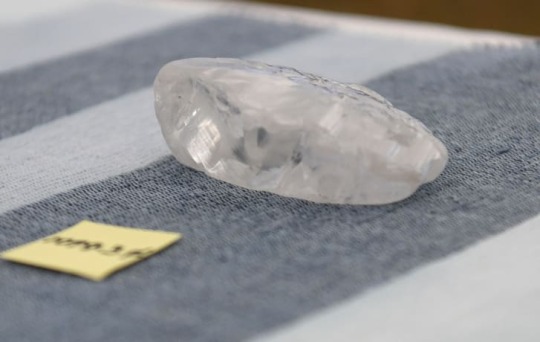
View On WordPress
0 notes
Text
World’s 3rd largest diamond found in Botswana
World’s 3rd largest diamond found in Botswana
A huge diamond weighing more than 1,000 carats, which could be the 3rd largest diamond mined in history, has been discovered in the southern African country of Botswana.
The high-quality gemstone weighing 1,098.3 carats was unearthed earlier this month in the Jwaneng mine owned by Debswana, the mining company jointly owned by the Botswanan government and the De Beers Group.
“With the recent…
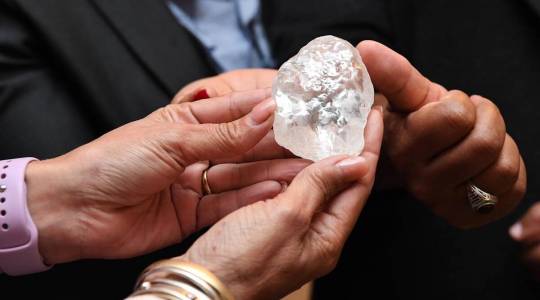
View On WordPress
#Diamonds in Botswana#Largest diamonds in the World#World’s 3rd largest diamond#World&039;s biggest diamonds
0 notes